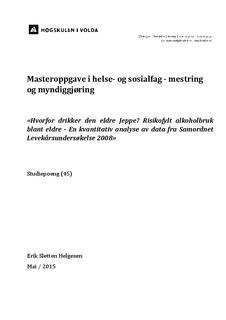| dc.contributor.author | Helgesen, Erik Sletten | |
| dc.coverage.spatial | 2008-2012 | |
| dc.coverage.spatial | Noreg | nn_NO |
| dc.date.accessioned | 2015-11-02T07:06:22Z | |
| dc.date.available | 2015-11-02T07:06:22Z | |
| dc.date.issued | 2015 | |
| dc.identifier.uri | http://hdl.handle.net/11250/2358912 | |
| dc.description.abstract | Abstract
Alcohol consumption in Norway has increased significantly in recent years. Meanwhile, there has been a change in the availability of alcohol and the Norwegians' attitudes towards alcohol. Alcohol consumption can cause major social and health problems, both for the individual and the society. Interest in alcohol problems among the elderly is relatively new and there are currently few studies with elderly alcohol consumption as the main theme. Thus, there is lacking knowledge about the health, social and economic impacts of alcohol consumption among the elderly.
Statistisk Sentralbyrå (SSB), in connection with the «Samordnet Levekårsundersøkelse 2008», collected the empirical data. This was a cross-sectional study, which includes health as one of the main areas. The data is divided into two age categories, under 65 years and 65 years or older.
The purpose of this study is to identify the key factors, which apparently have the greatest impact on alcohol consumption among the elderly people (over 65 years old). The study also attempts to determine whether these factors differ from factors that affect alcohol use among younger people (under 65 years).
There are four variables measuring alcohol consumption in the empirical data. Factor analysis combined these variables into an index, and the term "hazardous alcohol consumption" was established. Other statistical methods used are analysis of variance (t-tests and one-way analysis of variance (ANOVA)) and linear regression analysis.
The findings indicate that there are some differences regarding the factors that influence alcohol consumption in the two age groups. In the oldest group (65 years or older) gender, smoking and disability pension were statistically significant variables. In the youngest age group, a number of factors have an influence on alcohol consumption. In both age groups, gender, smoking and disability pension are of significant importance. Disability pension have different effects in the two age groups. In the youngest, it reduces the risk, while in the oldest it increases the risk.
In the discussion part of the master thesis, topics for further research as well as a conclusion are offered.
Key words: Alcohol consumption, elderly, gender, smoking, disability pension. | nb_NO |
| dc.description.abstract | Sammendrag
Alkoholforbruket i Norge har økt betydelig de siste årene. Samtidig har det vært en endring i tilgjengeligheten av alkohol og nordmenns holdninger til alkohol. Alkoholforbruk kan føre til store sosiale og helsemessige problemer, både for den enkelte og samfunnet. Interessen for alkoholproblemer blant eldre er relativt ny, og det er foreløpig få studier med eldre alkoholkonsum som hovedtema. Det er derfor behov for kunnskap om helse, sosiale og økonomiske konsekvenser av alkoholbruk blant eldre.
Målet med studien er å kartlegge hvilke sentrale faktorer som tilsynelatende har størst påvirkning på alkoholforbruket blant personer som er 65 år eller eldre. Jeg vil også forsøke å finne ut om disse faktorene skiller seg fra faktorene som påvirker yngre personer (under 65 år).
Kvantitative metoder ble brukt i denne studien ved at data som er samlet inn av Statistisk Sentralbyrå i forbindelse med «Samordnet levekårsundersøkelse 2008», analyseres. Dette var en tverrsnittsundersøkelse med blant annet helse som ett av hovedtemaene. I analysedelen er empirien delt inn i to alderskategorier, under 65 år og 65 år eller eldre. På denne måten kan man gjøre en komparativ analyse og undersøke om det er ulike variabler som påvirker risikofylt alkoholbruk hos de to aldersgruppene.
I datamaterialet er det fire alkoholvariabler. Disse ble ved hjelp av faktoranalyse kombinert til en indeks og begrepet «risikofylt alkoholbruk» ble etablert. Andre statistiske metoder som ble brukt, er variansanalyser (t-tester og enveis variansanalyse (ANOVA) og lineær regresjonsanalyser.
Analysene viste at det er noen forskjeller på faktorer som påvirkninger alkoholbruk i de to aldersgruppene. Hos den eldste gruppen (65 år eller eldre) fant man at kjønn, røyking og mottak av uførepensjon var signifikante forklaringsvariabler. Det er et mer sammensatt bilde hos den yngste aldersgruppen. Kjønn, røyking og uførepensjon er signifikante i begge aldersgruppene. Uførepensjon har ulik effekt i de to aldersgruppene. I den yngste reduserer den risikoen, mens i den eldste øker den risikoen.
Avslutningsvis pekes det på temaer for videre forskning. Helt til slutt oppsummeres oppgaven i en konklusjon.
Nøkkelord: Alkoholbruk, eldre, kjønn, røyking, uførepensjon. | nb_NO |
| dc.language.iso | nob | nb_NO |
| dc.publisher | Høgskulen i Volda | nb_NO |
| dc.subject | alkoholbruk | nb_NO |
| dc.subject | eldre menn | nb_NO |
| dc.subject | tobakksrøyking | nb_NO |
| dc.subject | uførepensjon | nb_NO |
| dc.subject.mesh | Alchol Drinking | en |
| dc.subject.mesh | Alcoholism | en |
| dc.subject.mesh | Risk-Taking | en |
| dc.subject.mesh | Smoking | en |
| dc.subject.mesh | Aged | en |
| dc.subject.mesh | Men | en |
| dc.subject.mesh | Insurance, Disability | en |
| dc.subject.mesh | Pensions | en |
| dc.subject.mesh | Employment | en |
| dc.title | Hvorfor drikker den eldre Jeppe? Risikofylt alkoholbruk blant eldre. En kvantitativ analyse av data fra Samordnet levekårundersøkelse 2008 | nb_NO |
| dc.type | Master thesis | nb_NO |
| dc.subject.nsi | VDP::Social science: 200::Sociology: 220 | nb_NO |
| dc.subject.nsi | VDP::Social science: 200::Social work: 360 | nb_NO |
| dc.source.pagenumber | 111 | nb_NO |
